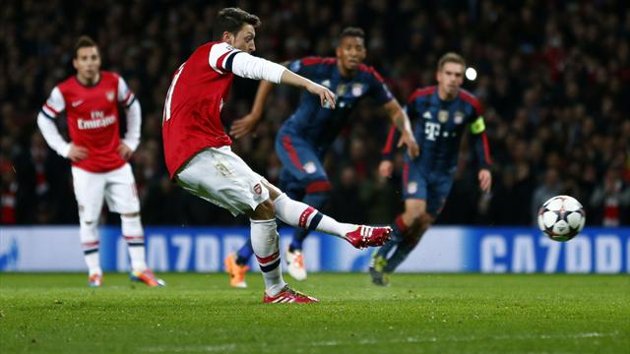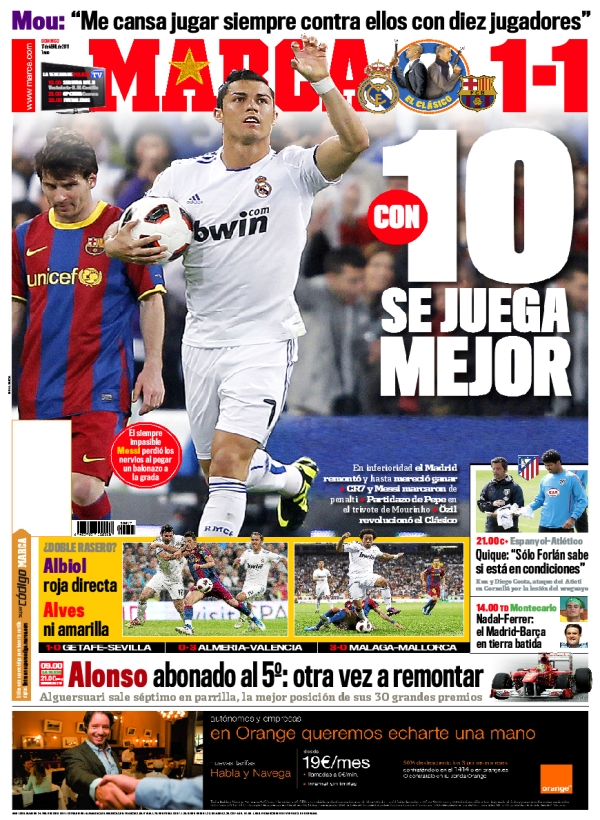Rob 11:17 PM If only...Arsenal weren't so fucked.
main
CommentarySpain
Los Clásicos As Amadeus Redux
After watching the second half of yesterday’s Clasico, I’m beginning to see Mourinho as Salieri to Guardiola’s Mozart. When a team of Madrid’s caliber gets schooled and forced into errant passes and frantic individual dribbles on offense and desperate tackles on defense, huffing shadow-chasing and hapless outreached hands pleading for offside calls that won’t come, the opposition must be touched by the divine; the divine stringing of passes, la pelota always kept just a fleeting inch away from Madrid’s lunging cleats, and importantly, the divine total defense, which at one point saw Özil attempting to dribble into the box only to be surrounded by seven (7!!) claret and blue shirts.
That is the intensity of Barca’s defensive strategy, immediate ganging up on the person with the ball, so that even if an opponent manages to dribble past one, or two, they never have the time to look for the pass because there will immediately be the third, and then its back to eluding the first again. Barca’s players attack at a leisurely tiki-taka pace, and save their bursts of speed for reclaiming the ball. This zealous, jealous demand for the return of the ball is as much part of the secret of their possession as it is their immaculate passing.
I want to see a team really try to take Barca on with their own style, pass for pass, tik for tak, rather than Mourinho’s vainglorious attempt to find an alternative way, trying fire against water, then air and iron, his mad doomed search for an antidote when perhaps what he needs is a vaccine?
[Editor’s note: If you missed the match, read Sid Lowe’s match report or his subsequent blog post (“Real Madrid damage image, reputation and status in defeat to Barcelona“). Or better yet, watch the video highlights below (at least before they’re taken down due to copyright infringment) or stream the full match from ESPN3.com’s archives.]
CommentaryScheduleTactics
What to Watch This Weekend: Athletic Bilbao-Barcelona, Guardiola Visits Bielsa
We’ve been remiss in posting our weekend TV guides the past couple weeks. This weekend we offer a belated and truncated version, consisting of a single match that’s kicking off in just a few hours: La Liga’s late match on Sunday, Athletic Bilbao hosting FC Barcelona, kicking off at 8pm in “la Catedral de futbol” Estadio San Mamés (which corresponds to 2pmET; televised in the US on ESPN Deportes, and also available via ESPN3.com).
Why only this match? Well, there weren’t any other matchups in England or across the continent this weekend that stood out as must-see TV. But this one is interesting on multiple levels.
There is the fact, of course, that it’s Barcelona, who we maintain you should watch whenever you get a chance. As we’ve heard ad nauseum, they are the greatest side of our era, featuring the best player of our time. Actually, featuring a number of the best players of our time—eight Barca players were among the 23 on the shortlist for this year’s Balon d’Or . In addition to the 3 finalists for last year’s award–Xavi, Iniesta, and award-winner Messi–also on the shortlist are Cesc Fabregas, David Villa, Dani Alves, Gerard Pique and Eric Abidal. (To be fair, Real Madrid wasn’t far behind with 5 nominees–Cristiano Ronaldo, Iker Casillas, Karim Benzema, Xabi Alonso, and Mesut Ozil.)
But it’s not only Barcelona. It’s also Athletic Bilbao–the Basque team which aspires to be one of the “alternatives” to the Barcelona/Madrid axis of hegemony in La Liga, which is newly managed by a crazy genius Argentine whom Pep Guardiola considers one of his managerial inspirations–to whose house in Argentina Guardiola made a pilgrimage when he was considering a career as a manager.
His name is Marcelo Bielsa, his arrival in Bilbao was highly anticipated, and his tenure there started terribly: two draws and three losses in their first five league matches. But they started to turn it around at the beginning of October, which prompted both of the Guardian’s cerebral football columnists Sid Lowe and Jonathan Wilson to devote columns to Bilbao under Bielsa.
Here is Sid Lowe’s column from Oct 3:
Marcelo Bielsa is a little less loco this morning. His Athletic Bilbao team won a game on Sunday and not just any game but the Basque derby:Real Sociedad versus Athletic Bilbao under the midday sun on the Bay of Biscay, Euskadi’s biggest match and one of Spain’s, too.
For the Argentine manager’s nickname is “loco Bielsa”–an eccentric genius who before this season had not managed in Europe, aside from an aborted stint at Espanayol back in 1998. But in the intervening 12 years he made his mark managing first his country’s national team (1998-2004) and then rival Chile’s (2004-2011); he resurrected the latter, taking them to 2nd in South American qualifying for South Africa, and Zonal Marking called “Bielsa’s Chile the most tactically-exciting side” going into that World Cup.
But Lowe describes how although Bielsa’s arrival was highly anticipated in Bilbao, Athletic has a formidable tradition and identity that he’s had to adapt to:
Spaniards are fond of telling you – if you are English anyway – that Athletic is the most English of clubs.
Visit San Mamés and it is hard to disagree. Athletic is the home of the giant defender and the battering-ram striker, of rain and mud, and roaring fans, of long balls and powerful headers. It is summed up in arguably the most famous remark ever uttered in Spanish football history, when José María Belausteguigoitia shouted: “Give me the ball, Sabino, I’ll flatten them” and promptly flattened them.
That was at the [1920] Antwerp Olympics and came to define the “Red Fury”, the Spanish style that was Basque. Bielsa was trying to change the approach; he was also trying to change one hundred years of history, and at the proud club that probably feels its history more keenly than any other.
Jonathan Wilson’s Guardian Sport Blog post addresses “The Question: Is Marcelo Bielsa’s model right for Athletic Bilbao?” and in typical Wilsonian fashion focuses on Bielsa’s tactics. Though he also alludes to Athletic Bilbao’s identity as the most English of Spanish clubs:
Athletic is a club with a clearly defined style of its own. The bowler-hatted figure of Fred Pentland, the Englishman who coached them through the glory years of the 20s and early 30s, still looms over the club, as an exhibition in the museum at San Mames makes clear. He first instituted a direct approach, favouring a robust, “English-style” centre-forward, a tradition that endures in the shape of Fernando Llorente, a remarkable combination of finesse and muscularity.
But he describes Bielsa’s model as potentially complementary to this direct approach–a style of “vertical football” defined as “getting the ball forward quickly without necessarily resorting to aimless long balls”–but combined with hard pressing high up the pitch (more on this tactical philosophy much further down below, and also in a Zonal Marking post from August titled “Bielsa set to thrive in Bilbao“).
PreviewTacticsVideo
El Clásico Series, Part 3: Champions League 1st Leg

Just when you thought El Clásico couldn’t get any more heated, Pep Guardiola took the rivalry to 11 in his press conference yesterday in Madrid. But the real battle of Mourinho contra Guardiola will take place on the pitch later today, with the 1st leg of the Champions League semifinal. It will remarkably be the 3rd meeting in the past 11 days between Guardiola’s Barcelona and Mourinho’s Real Madrid (following the tense 1-1 draw in a La Liga match on April 16 and Madrid’s dramatic 1-0 Copa del Rey victory a week ago), and the real battle will be the tactics the two managerial masterminds deploy today, in light of the past two matches–and in light of key absences for both squads. Here’s what you need to get ready for today’s match:
If you have time for nothing else, open up this post of ours from last November, containing both sides’ squad lists; also open up Marca’s very cool interactive graphic showing “Los sistemas de Mourinho y de Guardiola“–though given the injuries and suspensions, today’s starting XIs will not be any of the ones shown there. Keep reading..
If you’ve got more time, and haven’t been following our El Clásico coverage, catch up on last November’s initial La Liga meeting here and here (“This game more than any other has divided the CultFootball brain trust, with one faction supporting the brilliant arrogance of the establishment side and the other hoping the subversives from the north can one-touch their way a million times to victory.”). That match of course produced a stunning 5-0 victory for the Catalan club–what we called “Tiki-taka to La Manita” (that post includes two sets of video highlights from that instant classic El Clásico).
Like the rest of the footballing world, we’ve got loco for El Clásico over the past two weeks. Our preview of this four-game series is here. These words still hold true–but a couple key names mentioned here will be absent today due to injury (Iniesta for Barça, Khedira for Madrid):
So which team is in better form? Through most of the season it was clearly Barcelona, but they’ve seemed a tad shaky of late while Madrid are looking pretty comfortable on the pitch. Madrid have also had an entire season to learn Mourinho’s defensive principles…then again Barça tend to have their way with what seem at the outset to be the most prepared of teams.
The key to a Madrid victory will be to limit Messi’s time with the ball. When his teammates have looked less than otherworldly this season, the little Argentine has stepped up his game to amazing levels. Very often it’s some combination of Iniesta and Xavi that pop open the defenses, with Messi finishing the movement, but Khedira and Alonso will collapse on them very quickly and it’ll be up to Lionel in isolation (and also finding Villa moving off the shoulder of his defender).
For Barcelona to walk away with the win they’ll have to retreat quickly when they lose possession (Madrid have a very quick counter attack) and not give Özil any time on the ball. The young German is a key link between back and front, and with him contained Barça can maintain their high pressing and look to turn the ball over quickly, as they do.
After the Copa del Rey, the observation that Barcelona seems a tad shaky while Madrid is looking increasingly comfortable holds a fortiori–as well as the tactical observations about Messi on the ball and Madrid on the counterattack, with Madrid’s defensive midfield “trivote” tasked with collapsing on the former, and Özil certainly a key to the latter. See our multipart film session on the Copa del Rey final for illustrations of these points.
Madrid’s trivote in the previous two matches consisted of Khedira, Xabi Alonso, and Pepe. With Khedira out, look for Lass Diarra to step into the midfield. Might we see Kaka make an appearance in the midfield, and/or Higuain up front? The Brazilian midfielder and Argentine striker have both been absent this season due to injuries, but both played well over the weekend in Madrid’s 6-3 blowout of Valencia.
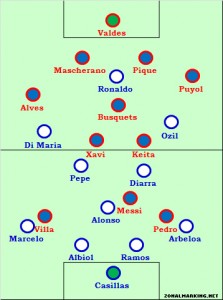
For Barcelona, their stalwart defender Puyol returns to lineup, but both Brazilian left wingbacks (Adriano and Maxwell) have been left back in Barcelona due to injury. Add to this Eric Abidal’s continued absence (due surgery in March to remove a tumor from his liver, although remarkably he returned to training this week), and Barcelona will again be forced into a suboptimal lineup in defense. Look for Mascherano to stay in the starting XI, though it’s not clear if he’ll be playing wingback. ZonalMarking speculates that Puyol will play on the left, while Mascherano will stay in the center. In either case, Barça likely won’t get the forward width they get from Adriano or Maxwell–but that may actually be a good thing, as Puyol or Mascherano will stay home and be more likely to prevent Madrid counterattacks up that wing. Hence, look for Madrid to concentrate even more on getting behind Dani Alves on the other side of the field–the diMaria-Alves matchup there is key.
Not having Iniesta in the midfield is of course a huge loss. In his stead, it will likely be the Malian Seydou Keita who pairs with Xavi and Busquets–though we may also see the 20-year old “wonderkid” Thiago Alcantara in action. Up front it will be the usual trio of Villa, Messi and Pedro.
We leave you with video of Pep’s presser yesterday–we are confident we will be using the phrase “el puto jefe y puto amo” with regularity in the future:
CommentarySpain
Real Madrid Lay Hands on the Copa del Rey
 Less than a week after their hard fought tie in league play, Madrid and Barça met in the final of the King’s Cup. Mourinho sent his defensive set into the midfield again, then put in Özil from the start for an added touch of creativity in attack, and sprinkled the whole side with an extra dose of aggression dust.
Less than a week after their hard fought tie in league play, Madrid and Barça met in the final of the King’s Cup. Mourinho sent his defensive set into the midfield again, then put in Özil from the start for an added touch of creativity in attack, and sprinkled the whole side with an extra dose of aggression dust.
The force of Madrid’s tackling and their quickness in closing down the Barça players immediately unstabilized the usually unflappable Blaugrana. On the strength of their defense and their quick counter attack, Madrid had far the better of the first half. Pepe seemed to be everywhere and Ronaldo did very well as the lone striker up top (even with Mascherano shadowing his every move). The game moved quickly up and down the pitch, but Barcelona weren’t finding any joy past the midfield circle and it wasn’t until nearly the 40th minute that they finally caused an overload close to goal (the chance fizzled without them manufacturing a shot).
Their one foray aside, Barcelona were lucky to get to the halftime whistle tied at zeroes, especially after Pepe’s towering header above Dani Alves smashed against the inside post and deflected at an agonizing angle across the goal mouth.
The second half was a different game entirely. Barcelona were rejuvenated by whatever spanking Pep Guardiola gave them in the dressing room, and they came out with the sort of belly fire you expect from the best team of their generation. Suddenly the game was stretched (in part because Madrid were pushing more into attack, but also because Xavi and Pedro were drawing out Pepe and Khedira more successfully) leaving Iniesta room to move through the middle.
It was in fact Iniesta who turned the game in Barça’s favor. In the first half, the playmaker forced passes into Messi and Villa only to find them sitting inside a trap. In the second half the tiny balding Spaniard held the ball and ran past the first defensive line of Madrid, then worked in closer proximity to his strikers so they could work the tiki taka. As soon as they found their rhythm the counter attack of Madrid started to look more like desperate clearing rather than pointed reply.
If not for Iker Casillas, Barça would have gone ahead in the second half, and considering the state of Madrid at the time they would probably not have found a way back. Spain’s number one tapped away a lovely chipped ball by Pedro and pushed aside an Iniesta strike destined for the corner.
It looked as if the game would head for extra time, until Madrid managed an odd man rush at the very end of the 90 minutes and di María found himself free to test Pinto from just outside the box. Valdés’s stand-in managed to palm the floating attempt above the bar and it was onto the next 30 minutes. More of the same for the most part. Hard tackling from Madrid but Barcelona with better control, though the chances had dried up.

Then just past the 100 minute mark Madrid found their way through the center of the pitch by way of another Pepe tackle. Marcelo swung the ball out to di María who got a toe in front of Alves to lift a far-side cross to the slicked head of Cristiano Ronaldo. The glistening head of the Portugese directed the ball past the unbalanced Pinto — Madrid 1 – 0 Barcelona.
Substitutions were made by both sides in the final fifteen minutes, but the score remained the same, and Real Madrid walked away with their first Copa del Rey in eighteen years. Then, Sergio Ramos dropped it under the party bus on the way back from the airport…
CommentaryHistoryNews
Marca on Madrid: “Con 10 Se Juega Mejor”
We’ve been digesting Saturday’s Real Madrid-Barcelona 1-1 draw at the Bernabeu–just the first installment of this month’s 4-part El Clásico series; the second is coming up this Wednesday with the Copa del Rey final, to be contested on neutral turf–at the Mestalla in Valencia. In the meantime, it’s always entertaining to see how Madridista tabloid Marca spins the latest big result.
There’s much to savor in this cover. The screaming lead (“Con 10 se juega mejor”) seems pedestrian enough. Translating to “It’s better to play with 10” (or “We play better with 10”?), Marca is seemingly remarking simply that Madrid played better after losing Albiol to a red card and playing a man short for the final 40 minutes of the match.
But it turns out the headline may actually be an allusion to an aphorism attributed to the legendary manager Helenio Herrera–which leads to something of a Möbius strip of historical resonances: Herrera, nicknamed Il Mago (“The Wizard”), is best known for managing Barcelona (1958-1960) and subsequently Inter Milan (1960-1968). His Barcelona sides successfully challenged the 5-time European champions Real Madrid on the domestic front. Then in Milan he gave birth to Catenaccio and led “La Grande Inter” to two consecutive European championships (1964 and 1965). Inter didn’t conquer Europe again until last year–led by Jose Mourinho of course, defeating Barcelona along the way in the semifinal, which led to headlines such as “In José Mourinho Inter finally have a true heir to Helenio Herrera.”
(For more on Herrera, confer this post on The Equaliser (which also has a post about La Grande Inter); Chapter 9 of Simon Kuper’s Soccer Against The World, titled “A Day with Helenio Herrera”; the chapter of Jimmy Burns’s Barça: A People’s Passion covering Herrera’s tenure at Barcelona, titled “El Salvador”; or this post titled “The Really Special One – Helenio Herrera.”)
Back to the Marca cover: Mou(rinho)’s comment on the matter gets put across the top (“Me cansa jugar siempre contra ellos con diez jugadores” / “I am tired of always playing against them with 10 players”), and Marca asks whether the “roja directo” (straight red) for Albiol versus no yellow (“ni amarilla”) for Alves on the respective penalties represents a double standard (“¿doble rasero?”).
Of course it’s CR7 and Messi that dominate the image–another fine piece of photoshopping. Ronaldo striding with the ball, looking up, clawing at the air like some sort of big cat (perhaps an allusion to Mourinho’s hunting with cats?), while Messi shuffles behind him, eyeing the ball, looking disturbed/disturbing.
But we also rather like the little image of Guardiola and Mourinho inserted at the top: the two managers with their backs to each other, pistols in hand. One round of the duel completed–three more to go.
CommentaryPreview
Barcenal: A Pregame Reading List
The marquee matchup of the Round of 16 is without a doubt Arsenal vs. Barcelona. That’s partly because Arsenal is the one group-stage favorite that slipped into 2nd place in their group (behind Shakhtar Donetsk, due to losses at Donetsk and at Sporting Braga), and hence had to draw a group winner for the Round of 16. But it’s also because these teams have an affinity, a rivalry, and a history.
Their rivalry comes out of their affinity and their history. Both play what might be called the Dutch style of football–one that emphasizes possession, with the ball on the ground, intricate and sustained buildup (the opposite of “Route one” football), one- and two-touch passing (tiki-taka, if you will), individual technical skill, movement off the ball, a fearful geometry of passing angles..all in all, various aspects of “total” football.
Indeed, this Dutch heritage is real, especially in Barcelona’s case: their spiritual leader is Johan Cryuff, who brought to Barcelona this style–or rather philosophy–from Ajax in the early ’70s, when he was the best player in the world. It was Cryuff who suggested that Barcelona set up a youth academy, similar to the Ajax Academy, which became the famous La Masia–“The House that Built Barca” (h/t to Sumit for the link).
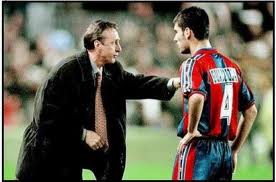
And Cryuff returned to Barcelona in the early ’90s, managing a group of fantastic players called Cryuff’s Dream Team–the “fulcrum” of which was a young midfielder named Pep Guardiola. Now of course Guardiola is manager–and some are saying Guardiola’s current team is better than those Barcelona teams; including some who played alongside Pep back then (“when they won the European Cup for the first time in 1992 and clinched four consecutive league titles between 1991 and 1994. That side featured the likes of Romario, Hristo Stoichkov and Ronald Koeman.)
Cryuff now dispenses his opinions and wisdom with weekly essays that appear in the Barcelona newspaper El Periódico. One of his recent entries was titled “El fútbol total del siglo XXI“–“Total Football for the 21st Century” (“Solo dos equipos, el Madrid de Di Stéfano y el Ajax de los años 70, habían sido capaces hasta ahora de reinventar el fútbol como lo está haciendo el de Guardiola” which translates to: “Only two teams, the Madrid of de Di Stefano and the Ajax of the early ’70s were able to reinvent the game as Guardiola’s team is now doing.”
With Arsenal, a similar “continental” style of play came to north London via France–Arsene Wenger arrived to manage Arsenal in the mid-’90s, after a decade managing in France. Although he’s perhaps best known for bringing to the Premier League French and African (and especially, perhaps, French-African), two of his most influential players in his first decade coaching at Arsenal were Dutch internationals Denis Bergkamps and Marc Overmars–and one of his most important right now is Dutch striker Robin van Persie.
But his most important player, Arsenal’s talisman, if you will, is Cesc Fabregas–a native Catalan whom Wenger signed away from Barcelona’s La Masia seven years ago, when Cesc was only 16. Apparently Cesc was convinced that he wouldn’t have the same opportunities to play at Barcelona that he has had at Arsenal, given the midfield talent that was being groomed at La Masia back then. But now Barcelona now wants to bring Fabregas back–which is one source of conflict between the clubs, and one of the major storylines of these meetings.
Consider this anecdote related in a BBC piece titled “The One That Got Away“:
As a player, Guardiola was very much the prototype of the modern Spanish midfielder: technically-gifted, balanced and an immaculate passer of the ball.
He was at the heart of Johan Cruyff’s all-conquering Barca side in the 1990s and was idolised by the young Fabregas as he made his way through the academy ranks.
Borrell, who has remained a friend and confidante to Fabregas, tells a story that encapsulates the connection between the Arsenal star and his one-time hero.
In 2001, when Fabregas was going through the pain of his parents’ divorce, Borrell persuaded Guardiola to sign his famous number four shirt for the young protege. On it, he wrote: ‘One day, you will be the number four of Barcelona.’
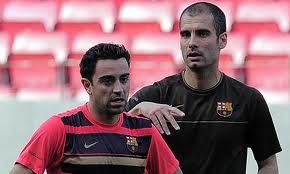
But for now, of course, the heart of the Barcelona midfield, the deus ex machina, is Xavi. Messi scores the goals, gets the press, gets the awards–but many thought it was Xavi that should have received the Balon d’Or this year, instead of Messi (but Xavi finished 3rd in the balloting–with Iniesta finishing 2nd!).
You must read this interview with Xavi that Guardian Football’s Spanish correspondent Sid Lowe conducted last weekend. An excerpt:
Think quickly, look for spaces. That’s what I do: look for spaces. All day. I’m always looking. All day, all day. [Xavi starts gesturing as if he is looking around, swinging his head]. Here? No. There? No. People who haven’t played don’t always realise how hard that is. Space, space, space. It’s like being on the PlayStation. I think shit, the defender’s here, play it there. I see the space and pass. That’s what I do.
That’s at the heart of the Barcelona model and runs all the way through the club, doesn’t it? When you beat Madrid, eight of the starting XI were youth-team products and all three finalists in this year’s Ballon d’Or were too – Lionel Messi, Andrés Iniesta and you.
Some youth academies worry about winning, we worry about education. You see a kid who lifts his head up, who plays the pass first time, pum, and you think, ‘Yep, he’ll do.’ Bring him in, coach him. Our model was imposed by [Johan] Cruyff; it’s an Ajax model. It’s all about rondos [piggy in the middle]. Rondo, rondo, rondo. Every. Single. Day. It’s the best exercise there is. You learn responsibility and not to lose the ball. If you lose the ball, you go in the middle. Pum-pum-pum-pum, always one touch. If you go in the middle, it’s humiliating, the rest applaud and laugh at you.
Your Barcelona team-mate Dani Alves said that you don’t play to the run, you make the run by obliging team-mates to move into certain areas. “Xavi,” he said, “plays in the future.”
They make it easy. My football is passing but, wow, if I have Dani, Iniesta, Pedro, [David] Villa … there are so many options. Sometimes, I even think to myself: man, so-and-so is going to get annoyed because I’ve played three passes and haven’t given him the ball yet. I’d better give the next one to Dani because he’s gone up the wing three times. When Leo [Messi] doesn’t get involved, it’s like he gets annoyed … and the next pass is for him.
See below for what Xavi has to say about Arsenal and English football. (With apologies to Sid Lowe and the Guardian, we’ve ended up excerpting the majority of the interview–so click thru and give them a pageview. Or even better, make sure you read everything Sid Lowe writes–no better English-language coverage of La Liga exists, as far as we can tell. In fact, click thru to Lowe’s breakdown of “Three lessons for Arsenal before they take on Barcelona“; namely–1: Internazionale, Champions League, 20 Apr 2010; 2: Sporting Gijón, La Liga 12 Feb 2010; 3: Real Madrid, La Liga 29 Nov 2010.)

